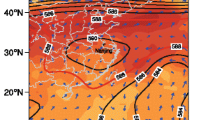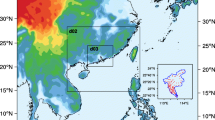Abstract
Urbanization is an extreme way in which human being changes the land use/land cover of the earth surface, and anthropogenic heat release occurs at the same time. In this paper, the anthropogenic heat release parameterization scheme in the Weather Research and Forecasting model is modified to consider the spatial heterogeneity of the release; and the impacts of land use change and anthropogenic heat release on urban boundary layer structure in the Pearl River Delta, China, are studied with a series of numerical experiments. The results show that the anthropogenic heat release contributes nearly 75 % to the urban heat island intensity in our studied period. The impact of anthropogenic heat release on near-surface specific humidity is very weak, but that on relative humidity is apparent due to the near-surface air temperature change. The near-surface wind speed decreases after the local land use is changed to urban type due to the increased land surface roughness, but the anthropogenic heat release leads to increases of the low-level wind speed and decreases above in the urban boundary layer because the anthropogenic heat release reduces the boundary layer stability and enhances the vertical mixing.








Similar content being viewed by others
References
Allen L, Lindberg F, Grimmond CSB (2011) Global to city scale urban anthropogenic heat flux: model and variability. Int J Climatol 31:1990–2005. doi:10.1002/Joc.2210
Block A, Keuler K, Schaller E (2004) Impacts of anthropogenic heat on regional climate patterns. Geophys Res Lett 31 doi:Artn L12211
Chen Y, Jiang WM, Zhang N, He XF, Zhou RW (2009) Numerical simulation of the anthropogenic heat effect on urban boundary layer structure. Theor Appl Climatol 97:123–134. doi:10.1007/s00704-008-0054-0
Chen F et al. (2011a) The integrated WRF/urban modelling system: development, evaluation, and applications to urban environmental problems. Int J Climatol 31:273–288. doi:10.1002/Joc.2158
Chen F, Miao S, Tewari M, Bao J-W, Kusaka H (2011b) A numerical study of interactions between surface forcing and sea breeze circulations and their effects on stagnation in the greater Houston area. J Geophys Res 116(D12)
Chen B, Shi GY, Wang B, Zhao JQ, Tan SC (2012) Estimation of the anthropogenic heat release distribution in China from 1992 to 2009. Acta Meteorol Sin 26:507–515. doi:10.1007/s13351-012-0409-y
Chou M-D, Kyu-Tae L, Si-Chee T, Qiang F (1999) Parameterization for cloud longwave scattering for use in atmospheric models. J Clim 12:159
Feng JM, Wang YL, Ma ZG, Liu YH (2012) Simulating the regional impacts of urbanization and anthropogenic heat release on climate across China. J Clim 25:7187–7203. doi:10.1175/Jcli-D-11-00333.1
Ferreira MJ, de Oliveira AP, Soares J (2011) Anthropogenic heat in the city of Sao Paulo, Brazil. Theor Appl Climatol 104:43–56. doi:10.1007/s00704-010-0322-7
Flanner MG (2009) Integrating anthropogenic heat flux with global climate models. Geophys Res Lett 36 doi:Artn L02801
Giovannini L, Zardi D, de Franceschi M, Chen F (2014) Numerical simulations of boundary-layer processes and urban-induced alterations in an Alpine valley. Int J Climatol 34(4):1111–1131
Han J-Y, Baik J-J (2008) A theoretical and numerical study of urban heat island-induced circulation and convection. J Atmos Sci 65:1859–1877. doi:10.1175/2007jas2326.1
Hou A, Ni G, Yang H, Lei Z (2013) Numerical analysis on the contribution of urbanization to wind stilling: an example over the Greater Beijing Metropolitan Area. J Appl Meteorol Climatol 52:1105–1115. doi:10.1175/jamc-d-12-013.1
Iamarino M, Beevers S, Grimmond CSB (2012) High-resolution (space, time) anthropogenic heat emissions: London 1970–2025. Int J Climatol 32:1754–1767. doi:10.1002/Joc.2390
Ichinose T, Shimodozono K, Hanaki K (1999) Impact of anthropogenic heat on urban climate in Tokyo. Atmos Environ 33:3897–3909. doi:10.1016/S1352-2310(99)00132-6
Kanda M, Inagaki A, Miyamoto T, Gryschka M, Raasch S (2013) A new aerodynamic parametrization for real urban surfaces boundary-layer. Meteorology 148:357–377. doi:10.1007/s10546-013-9818-x
Kaufmann RK, Seto KC, Schneider A, Liu ZT, Zhou LM, Wang WL (2007) Climate response to rapid urban growth: evidence of a human-induced precipitation deficit. J Clim 20:2299–2306. doi:10.1175/Jcli4109.1
Krpo A, Salamanca F, Martilli A, Clappier A (2010) On the impact of anthropogenic heat fluxes on the urban boundary layer: a two-dimensional numerical study boundary-layer. Meteorology 136:105–127. doi:10.1007/s10546-010-9491-2
Lazzarini M, Marpu PR, Ghedira H (2013) Temperature-land cover interactions: the inversion of urban heat island phenomenon in desert city areas. Remote Sens Environ 130:136–152. doi:10.1016/j.rse.2012.11.007
Lee SH, Song CK, Baik JJ, Park SU (2009) Estimation of anthropogenic heat emission in the Gyeong-In region of Korea. Theor Appl Climatol 96:291–303
LeMone MA, Tewari M, Chen F, Dudhia J (2013) Objectively determined fair-weather CBL depths in the ARW-WRF model and their comparison to CASES-97 observations. Mon Weather Rev 141(1):30–54
Li M, Song Y, Huang X, Li J, Mao Y, Zhu T, Cai X, Liu B (2014) Improving mesoscale modeling using satellite-derived land surface parameters in the Pear River Delta region, China. J Geophys Res Atmos 119:6325–6346
Lo JCF, Lau AKH, Chen F, Fung JCH, Leung KKM (2007) Urban modification in a mesoscale model and the effects on the local circulation in the Pearl River Delta region. J Appl Meteorol Climatol 46(4):457–476
Miao S, Chen F, LeMone MA, Tewari M, Li Q, Wang Y (2009) An observational and modeling study of characteristics of urban heat island and boundary layer structures in Beijing. J Appl Meteorol Climatol 48:484–501. doi:10.1175/2008JAMC1909.1
Miao S, Chen F, Li QC, Fan SY (2011) Impacts of urban processes and urbanization on summer precipitation: a case study of heavy rainfall in Beijing on 1 August 2006. J Appl Meteorol Climatol 50:806–825. doi:10.1175/2010jamc2513.1
Mlawer EJ, Taubman SJ, Brown PD, Iacono MJ, Clough SA (1997) Radiative transfer for inhomogeneous atmospheres: RRTM, a validated correlated-k model for the longwave. J Geophys Res Atmos 102:16663–16682. doi:10.1029/97jd00237
Narumi D, Kondo A, Shimoda Y (2009) Effects of anthropogenic heat release upon the urban climate in a Japanese megacity. Environ Res 109:421–431. doi:10.1016/j.envres.2009.02.013
Offerle B, Grimmond CSB, Fortuniak K (2005) Heat storage and anthropogenic heat flux in relation to the energy balance of a central European city centre. Int J Climatol 25:1405–1419. doi:10.1002/Joc.1198
Peng Z, Sun J (2014) Characteristics of the drag coefficient in the roughness sublayer over a complex urban surface boundary-layer. Meteorology. doi:10.1007/s10546-014-9949-8
Pigeon G, Legain D, Durand P, Masson V (2007) Anthropogenic heat release in an old European agglomeration (Toulouse, France). Int J Climatol 27:1969–1981. doi:10.1002/Joc.1530
Quah AKL, Roth M (2012) Diurnal and weekly variation of anthropogenic heat emissions in a tropical city, Singapore. Atmos Environ 46:92–103. doi:10.1016/j.atmosenv.2011.10.015
Sailor DJ (2011) A review of methods for estimating anthropogenic heat and moisture emissions in the urban environment. Int J Climatol 31:189–199. doi:10.1002/Joc.2106
Sailor DJ, Lu L (2004) A top–down methodology for developing diurnal and seasonal anthropogenic heating profiles for urban areas. Atmos Environ 38:2737–2748
Salamanca F, Martilli A, Tewari M, Chen F (2011) A study of the urban boundary layer using different urban parameterizations and high-resolution urban canopy parameters with WRF. J Appl Meteorol Climatol 50(5):1107–1128
Smith C, Lindley S, Levermore G (2009) Estimating spatial and temporal patterns of urban anthropogenic heat fluxes for UK cities: the case of Manchester. Theor Appl Climatol 98:19–35. doi:10.1007/s00704-008-0086-5
Sugawara H, Narita K (2009) Roughness length for heat over an urban canopy. Theor Appl Climatol 95:291–299. doi:10.1007/s00704-008-0007-7
Taha H (1997) Urban climates and heat islands: albedo, evapotranspiration, and anthropogenic heat. Energy Build 25:99–103. doi:10.1016/S0378-7788(96)00999-1
Trusilova K, Jung M, Churkina G, Karstens U, Heimann M, Claussen M (2008) Urbanization impacts on the climate in Europe: numerical experiments by the PSU-NCAR Mesoscale Model (MM5). J Appl Meteorol Climatol 47:1442–1455. doi:10.1175/2007jamc1624.1
Wang W (2009) The influence of thermally-induced mesoscale circulations on turbulence statistics over an idealized urban area under a zero background wind boundary-layer. Meteorology 131:403–423. doi:10.1007/s10546-009-9378-2
Wang Z, Wang X (2011) Estimation and sensitivity test of anthropogenic heat flux in Guangzhou. J Meteorol Sci (in Chinese) 31(4):422–430
Wang X, Liao J, Zhang J, Shen C, Chen W, Xia B, Wang T (2013) A numeric study of regional climate change induced by urban expansion in the Pearl River Delta, China. J Appl Meteorol Climatol 53:346–362
Yang L, Smith JA, Wright DB, Baeck ML, Villarini G, Tian F, Hu H (2013) Urbanization and climate change: an examination of nonstationarities in urban flooding. J Hydrometeorol 14:1791–1809. doi:10.1175/jhm-d-12-095.1
Zhang N, Gao ZQ, Wang XM, Chen Y (2010) Modeling the impact of urbanization on the local and regional climate in Yangtze River Delta, China. Theor Appl Climatol 102:331–342. doi:10.1007/s00704-010-0263-1
Zhang N, Chen Y, Zhao WJ (2012) Lidar and microwave radiometer observations of planetary boundary layer structure under light wind weather. J Appl Remote Sens 6.
Acknowledgments
This paper is supported by the National Basic Research Program of China (2011CB952002), the National Science Fund for Distinguished Young Scholars (41425020), the National Natural Science Foundation of China (41375014, 41275018), and China Special Fund for Meteorological Research in the Public Interest (GYHY201406031). We are grateful to the anonymous reviewers for their valuable comments.
Author information
Authors and Affiliations
Corresponding author
Rights and permissions
About this article
Cite this article
Zhang, N., Wang, X., Chen, Y. et al. Numerical simulations on influence of urban land cover expansion and anthropogenic heat release on urban meteorological environment in Pearl River Delta. Theor Appl Climatol 126, 469–479 (2016). https://doi.org/10.1007/s00704-015-1601-0
Received:
Accepted:
Published:
Issue Date:
DOI: https://doi.org/10.1007/s00704-015-1601-0




